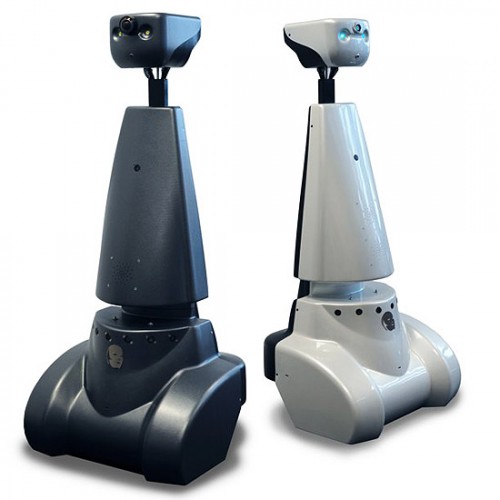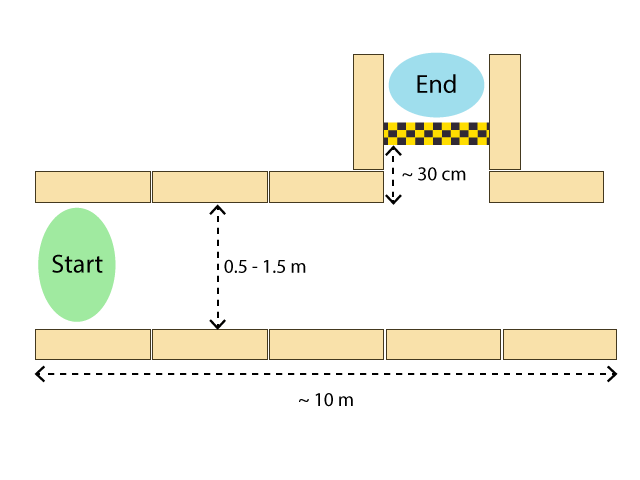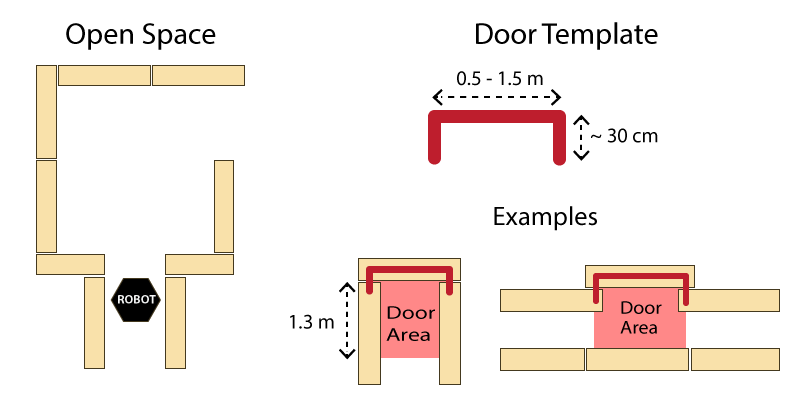Embedded Motion Control 2017
Guide towards the assignment
'A-MAZE-ING PICO'

Introduction
This course is about software design and how to apply this in the context of autonomous robots. The accompanying assignment is about applying this knowledge to a real-life robotics task.
Course Schedule and Lecture Slides
Lectures will be given on Wednesdays from 15.45 - 17.30 in Auditorium 14. The preliminary course schedule is as follows:
| April 26 | No Lecture: Ubuntu Installation & Tutorials (see Canvas!) | |
| May 3 | Introduction by René van de Molengraft | Tooling and Infrastructure by Wouter Kuijpers |
| May 10 | Best Practices in System Design for Robot Control by Herman Bruyninckx or Nico Huebel | |
| May 17 | First presentation of the design by the groups. | |
| May 24 | Corridor competition | Communication patterns by Herman Bruyninckx or Nico Huebel |
| May 31 | Invited talk by invited speaker. | |
| June 7 | Presentation of final design by the groups. | |
| June 14 | Final Competition | |
| June 21 | Deadline Wiki Pages | |
Assignment
Design and implement a robotic software system that will let robots Pico/Taco solve a maze in the robotics lab. The maze can contain doors that automatically open and close.
Corridor Competition
An intermediate review will be held (date to be determined) at the RoboCup soccer field. During this challenge, called the corridor competition the students have to let the robot drive through a corridor and then take the first exit. The precise location of this exit will not be given in advance. Some facts:
- Set-up
- Make sure your software is easy to set-up, i.e:
- Your software can be updated with one easy command, e.g. 'git pull'
- Your software can be compiled using 'cmake' and 'make'
- To start your software, only one executable has to be called
- If your set-up deviates from this method, let us know as soon as possible!
- The software of all groups will be updated on the robot before the challenge starts
- This way, teams starting the challenge have as much time as teams that do the challenge at the end
- Make sure your software is easy to set-up, i.e:
- The corridor:
- The exit can be either left or right
- It is not known beforehand how far the exit is located from the start (somewhere between 1 and 10 meters)
- The opposing end wall (on the far end) will be open
- The walls are approximately parallel to each other
- Note: the walls might not be perfectly straight
- The distance between the walls is not known in advance, but will be reasonable (somewhere between 0.5 and 1.5 meters).
- The distance between the walls will be fairly constant throughout the corridor, 'fairly' meaning that we build the corridor by hand, and the distance may change a little along the corridor.
- At the exit, the finish line is located approximately 30 cm from the side of the corridor (Notice: approximately, so don't just drive forward for 30 cm!). The walls that can be used to align PICO will be a little bit longer.
- Start, goal and limits:
- PICO will start with its laser range finder between the walls
- PICO will be approximately facing the end of the corridor. (Notice: approximately, so don't just drive forward for n seconds!)
- You have finished the assignment if PICO did not drive into walls, took the correct turn and the entire rear wheel is across the finish line.
- Maximum speed (is limited in PICO): 0.5 m/s translational, 1.2 rad/s rotational. By the way, that's pretty fast (compared to last year's 0.2 m/s), so be careful! You don't have to drive that fast!
- Scoring:
- Try not to touch the wall! Slightly touching is OK, however, bumping (i.e., driving head-on into a wall) is not allowed! If PICO hits the wall, we decide whether it counts as bumping. If PICO bumps into the wall, that trial ends immediately.
- Every team has two trials (= max one restart). A trial ends if:
- PICO bumps into the wall
- PICO has not moved or has not made sensible movements (as judged by the tutors) for 30 seconds
- The total time limit of 5 minutes per group is reached
- The group requests a restart (on the first trial)
- restart means:
- PICO restarts at the beginning of the corridor
- CORRIDOR time (= time used for scoring) is reset, BUT
- TOTAL time keeps running
- Every team has a total of 5 minutes
- There will be no second attempt if first attempt was successful
Next you can see an example of a corridor:

Maze Competition
The final competition will be held (date to be determined) at the RoboCup soccer field. The goal of this competition is to let PICO autonomously drive through a maze and find the exit. Some facts:
- Where and when:
- When: to be determined
- Location: RoboCup Soccer field, GEM-N
- Set-up
- Make sure your software is easy to set-up, i.e:
- Your software can be updated with one easy command, e.g. 'git pull'
- Your software can be compiled using 'cmake' and 'make'
- To start your software, only one executable has to be called
- If your set-up deviates from this method, let us know as soon as possible!
- Make sure your software is easy to set-up, i.e:
- Maze characteristics:
- Exact location of the exit is unknown, but it will be on the boundaries of the maze (which means: PICO has to drive out of the maze).
- Walls are approximately axis-aligned, meaning all angles are 90 degrees. Approximately means: built by hand, so slight differences may occur.
- Open spaces may occur
- There may be loops in the maze, which means that some walls may not be connected to other walls.
- Start, goal and limits:
- PICO will start inside the maze.
- PICO will not start in a door area (see below for definition). So, for example, the door will not be directly behind PICO's starting location
- You have finished the assignment if PICO did not drive into walls, found the exit and the whole robot is across the finish line.
- Maximum speed (is limited in PICO): 0.5 m/s translational, 1.2 rad/s rotational. By the way, that's pretty fast (compared to last year's 0.2 m/s), so be careful! You don't have to drive that fast!
- Doors:
- There is exactly 1 door in the maze
- The door will be situated at a dead end, a dead end being defined as a piece of wall with minimum length 0.5 and maximum length 1.5 with side-walls of at least 0.3 meter length. (Picture explaining this will follow shortly)
- There might be multiple dead ends in the maze, one of which is a door
- You need to pass the door to solve the maze, i.e., if you cannot open the door, the maze is unsolvable
- The door will open if and only if the following conditions are met:
- PICO is located within 1.3m distance from the door (i.e., no part of PICO is located outside the 1.3m range). The 1.3m in front of the door is called the door area.
- PICO is not driving, i.e., the commanded velocity is 0 (both translational and rotational)
- PICO asks to open the door. This will become available from the io-layer, e.g.,:
io.requestOpenDoor()
- If these conditions are met:
- The door will start sliding open within 2 seconds from PICO's request
- The door will slide open to the left or to the right
- The door slides open at approximately constant velocity
- The door is fully open within 5 seconds from PICO's request
- Once the door is open, it will stay open
- Scoring:
- You have 2 attempts (= maximum one restart)
- restart means:
- PICO restarts at beginning of maze
- MAZE time (= time used for scoring) is reset, BUT
- TOTAL time keeps running
- You have a total of 7 minutes for both attempts
- Hit wall = that attempt fails
- PICO standing still for 30 seconds = that attempt fails
- There will be no second attempt if first attempt was successful
Next you can see an examples of an open space and a door and examples:

The maze of the final maze challenge is shown in the figure below. You can download this and try it in the simulator, to show that you are able to finish the maze in simulation.

Getting Started
To get started, please do the tutorials on the Tutorial Page. Please note:
- Do all tutorials, and all steps. Missing one step may cause a different behavior or incorrect working system later. If something is not working as expected, make sure you correctly did all previous steps.
- Of course, things may still go wrong. If so, do not hesitate to contact us.
- See Using Pico for a quick overview of how to use Pico.
FAQ
Here you can find a collection of Frequently Asked Questions. Please check this page before contacting the student assistants or the tutors! If you find any issues or questions you had to deal with, please add them as well so your colleagues don't run into the same problems.
Group Wiki Pages
Group 1 - visit wiki - Tutor: tbd
Karel van de Plassche
Joey Hendriks
Ioannis-Dionysios Bratis
Jad Haj Mustafa
Jip Reinders
juliana langen
Group 2 - visit wiki - Tutor: tbd
Daniël Pijnenborg
Joep Linssen
Matthijs van der Burgh
Sil Schouten
Rens Slenders
Joeri Roelofs
Group 3 - visit wiki - Tutor: tbd
Ayisha wafa
Aparnasri Sekar
Nick Peters
Group 4 - visit wiki - Tutor: tbd
Mathijs Schouten
Niels Janssen
Rik Winters
Mickey Beurskens
Melvin de Wildt
Joey Verest
Group 5 - visit wiki - Tutor: tbd
Angel Molina
Sjoerd Knippenberg
Torben Beernaert
Bart Vercoulen
Rodrigo Estrella
Kagan Incetan
Group 6 - visit wiki - Tutor: tbd
Lars Moormann
Ties Hoenselaar
Jeroen van der Velden
Laura de Jong
Bas Straatman
Hasan Ilisu
Group 9 - visit wiki - Tutor: tbd
Mian Wei
Zhihao Wu
Petrus T Handoko
Bo Deng
Bo Cong
Jian Wen Kok
Group 10 - visit wiki - Tutor: tbd
Tim Coerver
Bas Vermij
Pieter de Groot
Jos Terlouw
Corné van Haren
Roel Vromans
Pico test schedule
Be sure you have your software on git before coming to the test session so that you only have to git clone/git pull to get your code on the robot!
Please charge the robot whenever possible so there is no down time due to empty batteries.
Submissions are last checked the day before at 22:00.
It is possible to test on the robot outside of the scheduled time, but know that this is unsupported. Make sure that when you want to test on the robot outside the schedule you add your time to the schedule and put an asterix after the time. Know that other people need to use the field as well (Tech United etc.) and outside the scheduled time these parties have precedence over you. Also know that you can only test once a week, so scheduling twice in a week is not allowed.
| Date | Time | Group |
|---|---|---|
| date | time | group |
Group Final Presentations
To be added...
Contact Details
Tutors
Yanick Douven - y dot g dot m dot douven at tue dot nl
Wouter Kuijpers - w dot j dot p dot kuijpers at tue dot nl
Wouter Houtman - w dot houtman at tue dot nl